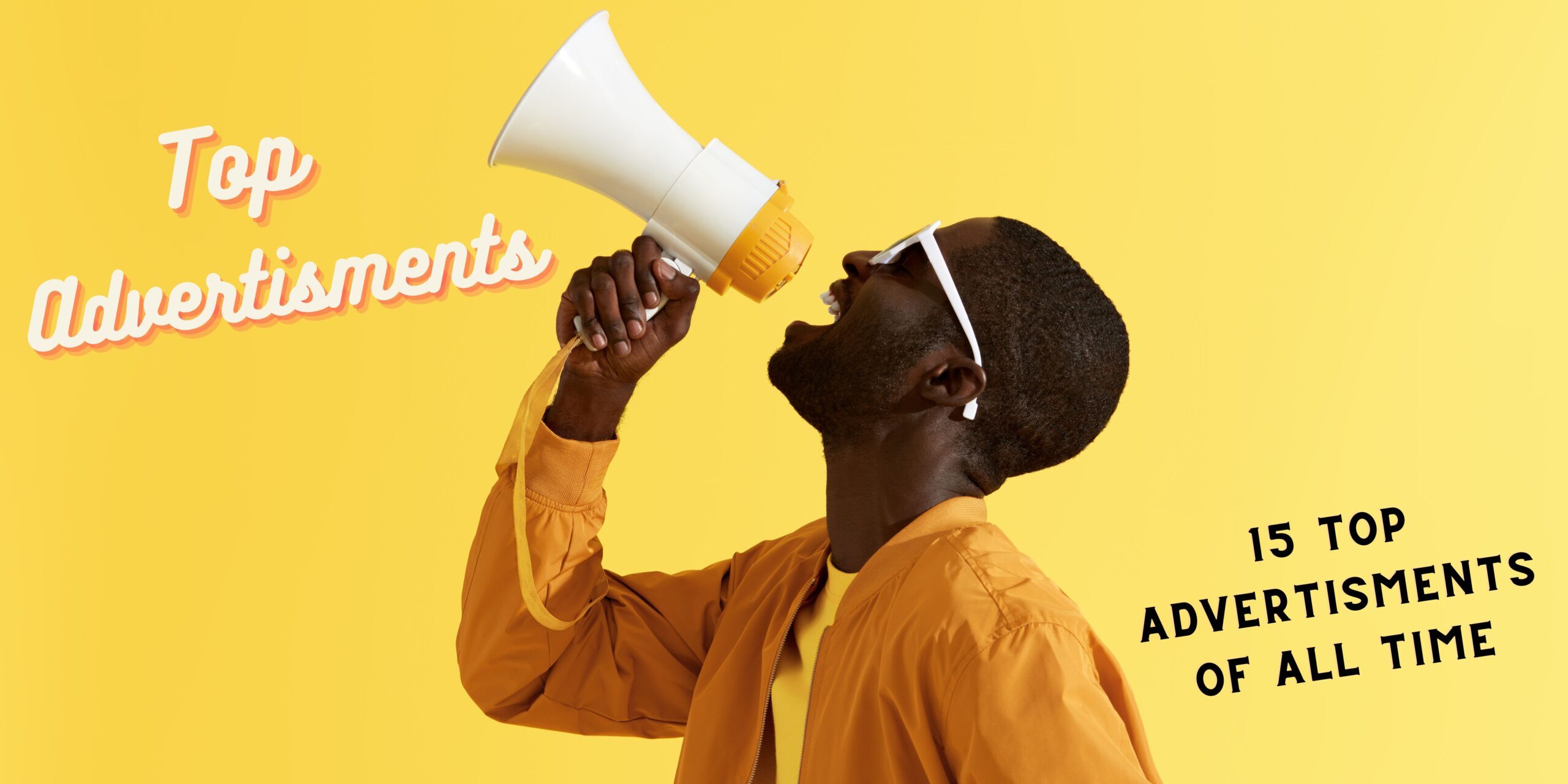
26 Mar 15 TOP ADVERTISEMENTS OF ALL TIME
In an era where the digital landscape is continually evolving, advertising stands as a testament to the resilience and adaptability of modern business strategies. Its role, far from being a mere tool for selling, has grown into a multifaceted instrument of communication, brand building, and even social engagement. This evolution reflects not just in how companies reach out to their potential customers but also in how audiences perceive and interact with advertisements. Gone are the days when advertising was simply about getting the word out. Today, it’s about creating a narrative, evoking emotion, and, most importantly, establishing a connection.
The journey of advertising from traditional mediums such as print, radio, and television to the digital platforms of today tells a story of innovation and persistence. Businesses that once relied solely on billboards and newspaper ads now leverage the power of social media, search engines, and even virtual reality to capture the attention of their audiences. This shift is not merely a change in medium but a transformation in approach. Digital advertising allows for a level of personalization and engagement previously unimaginable, offering advertisers unprecedented insights into their audience’s preferences, behaviors, and even future needs.
However, with great power comes great responsibility, and the move to digital has not been without its challenges. Advertisers today face a landscape that is more competitive than ever, with consumer attention split across numerous channels and platforms. The digital age has brought with it the phenomenon of ad fatigue, where consumers become desensitized to advertising due to overexposure. Additionally, the rise of ad-blocking technology poses a significant hurdle, compelling advertisers to be more creative and less intrusive in their approach.
This backdrop sets the stage for the importance of creativity and strategic thinking in advertising. It’s no longer enough to simply broadcast a message and hope for the best. Successful campaigns now rely on a deep understanding of the target audience, clever use of data analytics, and an ability to tell a story that resonates. Creativity in advertising isn’t just about being original or visually stunning; it’s about finding innovative ways to overcome the myriad challenges of the digital world, from cutting through the noise to connecting with an increasingly discerning audience.
Moreover, strategy in advertising has evolved from mere planning to a sophisticated process of research, analysis, and adaptation. Advertisers must navigate the complexities of global markets, cultural nuances, and constantly changing consumer trends, all while ensuring their message aligns with the brand’s core values and objectives. The strategic deployment of advertisements across various channels, each with its own set of rules and potential, requires a delicate balance between consistency and customization.
Here at Amra & Elma, we explore the best advertisements that have left an indelible mark in the advertising industry and people’s hears and minds. As we delve deeper into the nuances of modern advertising, it becomes clear that the industry is at a pivotal point. The convergence of creativity and strategy, underpinned by technological advancements, is driving advertising into new realms of effectiveness and influence. This introduction serves as a gateway to understanding how advertising has become a critical component of modern business, shaping not just consumer behavior but the very fabric of society itself. Through a detailed exploration of its foundations, types, and techniques, as well as a look into the future of advertising, we aim to provide insights into creating campaigns that not only capture attention but also inspire action and foster lasting connections.
15 Best Advertisements of All Time
1. Nike
2. Coca Cola
3. Apple
4. Old Spice
5. Dove
6. Volkswagen
7. Red Bull
8. Absolut Vodka
9. McDonalds
10. De Beers
11. Always
12. Ikea
13. Budweiser
14. Google
15. Chipotle
Foundations of Advertising
The tapestry of advertising is as old as commerce itself, beginning with ancient civilizations using simple yet effective methods to promote their wares. However, the formal journey of advertising as we know it embarked in the 15th century with the advent of print media. The first printed advertisements were stark, text-heavy notices in newspapers, evolving over centuries into the creative, visually compelling print ads of magazines and billboards.
The 20th century marked a revolutionary leap with the introduction of radio and television advertising, allowing brands to enter homes and daily lives, creating a new intimacy with consumers. This era saw the birth of jingles, catchphrases, and mascots that have become cultural icons. As impactful as these mediums were, they offered limited interaction and relied heavily on broad demographic targeting.
The digital revolution transformed the advertising landscape, introducing the internet as a new frontier. This era ushered in unprecedented opportunities for targeting and personalization, thanks to the wealth of data available online. Digital advertising spans various formats, from search engine ads and social media campaigns to video ads and influencer partnerships. Each evolution has expanded the advertisers’ toolkit, allowing for more nuanced, engaging, and effective campaigns.
What is Advertising?
Key Terms Clarified:
- Advertising: The action of calling public attention to something, especially by paid announcements.
- Campaign: A series of coordinated advertisements across one or more channels, designed to achieve a particular goal.
- Engagement: The level of interaction and attention consumers have with an advertisement, often measured by actions such as clicks, likes, and shares.
Common Challenges:
The digital age, while opening new doors, has also presented unique challenges:
- Ad Fatigue: Consumers today are bombarded with an overwhelming volume of ads, leading to disengagement.
- Platform Saturation: With the plethora of platforms available, finding the right mix that reaches the target audience effectively has become more complex.
- Privacy and Data Concerns: Increasing scrutiny and regulation around data usage demand that advertisers tread carefully in how they collect and utilize consumer information.
Types and Techniques of Advertisements
Overview of Advertisement Types
The advertising realm is rich and diverse, offering a myriad of types and techniques designed to reach and influence target audiences. Each type serves unique purposes and is chosen based on the campaign goals, target audience, and the message to be conveyed.
- Print Advertising: Once the backbone of advertising, print remains relevant for targeting local demographics or niche markets. It includes newspapers, magazines, brochures, and posters, offering longevity in message delivery.
- Digital Advertising: This encompasses a broad range of online formats such as display ads, search engine marketing (SEM), social media ads, email marketing, and mobile advertising. Its strength lies in its vast reach and the ability to precisely target and track audience engagement.
- Social Media Advertising: Platforms like Facebook, Instagram, Twitter, and LinkedIn offer targeted advertising solutions that cater to specific demographics, interests, and behaviors. These ads can be tailored for engagement, website visits, or conversions, making them highly versatile.
- Radio Advertising: Despite the rise of digital, radio ads continue to be a powerful medium, especially for reaching local markets and driving community engagement.
- Television Advertising: TV ads have a broad reach and the power to deliver a message through a compelling combination of sight, sound, and motion.
- Outdoor Advertising: Billboards, bus stops, and transit ads make up this category, offering high visibility in specific locations.
- Emerging Platforms: Augmented Reality (AR), Virtual Reality (VR), and interactive ads are gaining traction, providing immersive experiences that can dramatically boost engagement and brand recall.
Best Advertisements of All Time
1. Nike: “Just Do It” (1988)
Launched in 1988, Nike’s “Just Do It” campaign transcended the realm of sportswear advertising to become a cultural phenomenon. It encapsulated the spirit of perseverance and determination, appealing not just to athletes but to anyone facing a challenge. The campaign’s success lies in its ability to inspire and motivate, driving Nike to unprecedented growth and solidifying its place in the global market.
Empowering Athletes Everywhere
Nike’s “Just Do It” campaign is more than just an advertising slogan; it’s an ethos that has inspired athletes around the world for over three decades. Launched in 1988, this campaign captured the spirit of perseverance and determination, encouraging people of all ages and skill levels to push beyond their limits and embrace the joy of sports. The simplicity and universality of “Just Do It” turned it into a rallying cry for anyone striving to achieve their personal best, solidifying Nike’s position as a brand that champions the inner athlete in everyone.
A Slogan That Became a Cultural Icon
The genius behind the “Just Do It” campaign lies in its motivational message, capable of resonating with a wide audience beyond just sports enthusiasts. Nike’s strategy of pairing the slogan with high-profile athletes and compelling narratives in their commercials played a crucial role in its success. However, it’s the way “Just Do It” transcends advertising to become a part of global culture that truly marks its significance. This phrase has been adopted by schools, motivational speakers, and even social movements, showcasing its impact.
Driving Brand Identity and Growth
The “Just Do It” campaign has had a profound effect on Nike’s brand identity and business growth. It helped position Nike as a lifestyle brand that goes beyond footwear and apparel, advocating for an active and determined way of life. The campaign’s enduring popularity has not only boosted sales but also created a loyal customer base that identifies with Nike’s empowering message.
Lessons in Timeless Branding
Nike’s “Just Do It” campaign offers invaluable lessons in crafting a message that stands the test of time. It shows the power of a simple, strong, and emotionally resonant slogan to build a brand identity that inspires and motivates. For marketers, “Just Do It” serves as a prime example of how authenticity and a deep understanding of your audience’s values can create a legacy that lasts far beyond the lifespan of a typical ad campaign.

2. Coca-Cola: “Share a Coke” (2011)
Coca-Cola personalized bottles with common names, inviting consumers to share a Coke with friends and loved ones. This initiative turned ordinary soda bottles into keepsakes and conversation starters, significantly boosting sales and social media engagement worldwide. The campaign’s genius was in leveraging personalization at scale, making each consumer feel uniquely acknowledged.
Personalization Meets Classic Refreshment
Launched in Australia in 2011, Coca-Cola’s “Share a Coke” campaign revolutionized the way brands connect with their consumers on a personal level. By replacing its iconic logo on bottles with common names, Coca-Cola invited customers to find a bottle with their name or that of a friend or loved one, making the act of sharing a Coke a more personal and engaging experience. This innovative approach not only breathed new life into the brand but also transformed a simple beverage purchase into a personalized act of connection.
Crafting Connections Through Names
The strategy behind “Share a Coke” was rooted in the power of personalization and social sharing. Coca-Cola tapped into the universal desire for recognition and belonging by featuring a wide array of names on its products, encouraging consumers to actively seek out and share bottles. This campaign extended beyond the physical product to social media, where consumers eagerly posted photos of their personalized Cokes, further amplifying the campaign’s reach and impact. The inclusion of popular and culturally diverse names allowed the campaign to resonate across a broad demographic, reinforcing Coca-Cola’s global appeal.
A Refreshing Boost to Engagement and Sales
The “Share a Coke” campaign had a tangible impact on Coca-Cola’s brand engagement and sales figures, reinvigorating the brand’s image and fostering a deeper emotional connection with consumers. The campaign’s success led to its expansion worldwide, with each region tailoring the experience to its unique cultural context. This global rollout underscored the universal appeal of personalized marketing, showcasing Coca-Cola’s ability to innovate while staying true to its heritage.
Lessons in Personalized Marketing
The “Share a Coke” campaign stands as a testament to the effectiveness of personalized marketing in creating meaningful brand experiences. It illustrates how customization can transform a generic product into something unique and special, deepening consumer engagement and loyalty. For marketers, Coca-Cola’s strategy highlights the importance of embracing innovative approaches to connect with consumers on a personal level, turning everyday moments into memorable brand interactions.

3. Apple: “Think Different” (1997)
In the late ’90s, Apple was struggling. The “Think Different” campaign was a bold statement of Apple’s brand identity, aligning itself with the rebels, visionaries, and geniuses who change the world. This campaign played a crucial role in Apple’s turnaround, resonating deeply with consumers and reestablishing Apple as a brand for creative and innovative thinkers.
A Manifesto for Innovation
In 1997, Apple’s “Think Different” campaign stood as a bold declaration of the company’s revival and its commitment to innovation. Amidst financial struggles and an identity crisis, Apple repositioned itself not just as a computer company, but as a beacon of creativity and rebellion against the status quo. The campaign, featuring black-and-white imagery of iconic figures who changed the world, served as both a homage to these trailblazers and a mirror to Apple’s ethos. It wasn’t just an advertisement; it was a statement of purpose, encouraging people to challenge conventions and see the world in new ways.
Celebrating the Rebels and the Visionaries
The genius of “Think Different” lay in its simplicity and depth. By associating Apple with legendary figures like Albert Einstein, Martin Luther King Jr., and John Lennon, the campaign elevated the brand to a symbol of genius and creativity. This strategic alignment with individuals known for challenging norms and making significant impacts in their fields underscored Apple’s message of innovation and individuality. It resonated deeply with consumers, particularly creative professionals, who saw Apple products as tools to help realize their own potential to think differently.
Reigniting the Apple Brand
The “Think Different” campaign marked a turning point for Apple, reigniting interest in the brand and setting the stage for its remarkable resurgence and future successes. It not only helped differentiate Apple in a crowded market but also rebuilt its image as an industry leader in innovation and design. The campaign’s lasting legacy can be seen in how Apple continues to be perceived as a company that pushes boundaries and inspires its customers to do the same.
Lessons in Brand Transformation
Apple’s “Think Different” campaign offers valuable lessons in the power of branding to transform a company’s image. It shows that a well-crafted message that aligns with a company’s core values can resonate on a deep level with consumers, inspiring loyalty and admiration. For marketers, the campaign underscores the importance of storytelling in creating an emotional connection with your audience, turning a brand into a symbol of broader ideals and aspirations.
4. Old Spice: “The Man Your Man Could Smell Like” (2010)
Old Spice redefined its image with this humorous and viral campaign, targeting women who buy men’s grooming products. Featuring Isaiah Mustafa delivering monologues with surreal, rapid-fire transitions, the ads were a hit on social media, significantly increasing sales and rejuvenating the brand’s image.
Redefining Masculinity with Humor
In 2010, Old Spice launched “The Man Your Man Could Smell Like” campaign, turning the tide for the brand’s image with a blend of humor, surrealism, and charisma. Starring Isaiah Mustafa delivering a monologue with seamless transitions through various fantastical scenarios, the ad captured the audience’s attention for its creativity, humor, and the unforgettable tagline. This campaign successfully broke through the conventional advertising noise, appealing not just to men but also to women who influence purchasing decisions in households, making Old Spice relevant in a crowded market.
A Viral Sensation Overnight
The strategy behind this campaign was as ingenious as it was bold. Old Spice leveraged social media platforms, which were burgeoning at the time, to create an interactive experience. Following the ad’s initial success, the brand released personalized video responses from Mustafa to questions and comments from fans on Twitter, Facebook, and other social media sites. This innovative approach to engagement transformed the campaign into a viral sensation, significantly boosting Old Spice’s visibility and appeal across a broad audience.
Refreshing the Brand’s Image
“The Man Your Man Could Smell Like” campaign not only revitalized Old Spice’s image but also set new benchmarks for digital marketing engagement. It showed the power of integrating traditional advertising with interactive social media tactics to amplify a brand’s message. The campaign’s success was evident in the spike in sales and the rejuvenation of Old Spice’s brand, proving that with the right creative approach, even established brands can reinvent themselves and connect with younger generations.
Lessons in Creative Engagement
Old Spice’s campaign demonstrates the effectiveness of humor and creativity in capturing the audience’s attention and fostering brand engagement. It highlights the importance of understanding the changing dynamics of media consumption and the potential of social media to create conversations around a brand. For marketers, this campaign serves as a case study in the power of innovative content and direct audience interaction to achieve widespread brand recognition and loyalty.
5. Dove: “Real Beauty” (2004)
Challenging the beauty industry’s standards, Dove’s “Real Beauty” campaign showcased women of various ages, sizes, and ethnicities, celebrating natural beauty. This powerful message of inclusivity and self-esteem sparked global conversations, enhancing Dove’s brand image as a champion for women’s confidence.
Challenging Beauty Norms
Dove’s “Real Beauty” campaign, launched in 2004, marked a significant departure from traditional beauty advertising, aiming to broaden the definition of beauty. This groundbreaking initiative featured women of various ages, sizes, and ethnicities, celebrating natural beauty in a way seldom seen in the industry. By focusing on real people rather than models, Dove not only challenged societal norms but also initiated a global conversation about beauty standards, self-esteem, and body positivity.
A Reflection of Real Life
The strategy behind the “Real Beauty” campaign was rooted in authenticity and inclusivity. Dove conducted a global study on beauty and discovered a significant gap between how beauty is portrayed in the media and the reality of what women see in themselves. Addressing this disparity, Dove’s campaign used real-life stories and images to reflect and celebrate the diversity and uniqueness of individual beauty. This approach not only resonated deeply with audiences but also set Dove apart as a brand committed to real representations of women.
Impacting Brand Perception and Beyond
The “Real Beauty” campaign had a profound impact, not only on Dove’s brand image but also on the beauty industry as a whole. It paved the way for more inclusive and diverse representations in advertising, encouraging other brands to follow suit. The campaign also led to the creation of the Dove Self-Esteem Project, further cementing Dove’s commitment to making a positive impact on women’s lives around the world.
Lessons in Authentic Branding
Dove’s “Real Beauty” campaign offers powerful lessons in the importance of authenticity and social responsibility in marketing. It demonstrates that brands can lead with values and make a significant social impact, all while fostering a deep connection with their audience. For marketers, Dove’s approach underscores the value of challenging industry norms and embracing a more inclusive vision of beauty, proving that real change can begin with a bold advertising campaign.

6. Volkswagen: “Think Small” (1959)
At a time when big cars were the norm, VW’s “Think Small” campaign played against conventional wisdom. The minimalist ads highlighted the Beetle’s small size and simplicity as advantages, effectively establishing Volkswagen in the American market and revolutionizing advertising copy and design.
Revolutionizing Auto Advertising
In 1959, Volkswagen’s “Think Small” campaign transformed automotive advertising with its minimalist approach and focus on simplicity. At a time when American cars were all about size and power, Volkswagen took a radically different approach by highlighting the compact size and efficiency of the Beetle. The “Think Small” ad featured a small image of the Beetle against a plain white background, accompanied by witty and honest copy that embraced the car’s simplicity and practicality. This campaign not only differentiated Volkswagen in a crowded market but also challenged consumers to reconsider their perceptions of what makes a car desirable.
A Lesson in Honesty and Humor
The strategy behind “Think Small” was groundbreaking for its use of honesty, humor, and simplicity. By embracing the Beetle’s unique qualities and turning perceived weaknesses into strengths, Volkswagen established a brand identity that was approachable and trustworthy. The campaign’s straightforward tone and refusal to conform to typical automotive advertising clichés resonated with a broad audience, setting a new standard for how products could be marketed.
Driving a Cultural Icon
The impact of the “Think Small” campaign was profound, solidifying the Volkswagen Beetle’s place in American culture. It not only increased sales significantly but also built a lasting brand loyalty that continues to this day. The campaign is credited with being one of the greatest advertising strategies of the twentieth century, influencing generations of marketers to value clarity, honesty, and creativity in their advertising efforts.
Lessons in Minimalist Marketing
Volkswagen’s “Think Small” campaign offers timeless lessons in the power of minimalist marketing and the importance of authenticity. It shows that by embracing and highlighting a product’s true nature, rather than relying on exaggeration or hyperbole, brands can create a meaningful connection with their audience. For marketers, “Think Small” remains a masterclass in how simplicity and honesty can cut through the noise to deliver a powerful and enduring message.

7. Red Bull: “Stratos” (2012)
Red Bull took its slogan “Gives You Wings” to new heights with the Stratos project, sponsoring Felix Baumgartner’s jump from the edge of space. The event, live-streamed on YouTube, exemplified branded content that entertains, engages, and inspires, further cementing Red Bull’s association with extreme sports and adventure.
Defying Limits with a Leap from the Stratosphere
In 2012, Red Bull took brand marketing to new heights with the “Stratos” campaign, featuring Felix Baumgartner’s record-breaking skydive from the edge of space. This daring feat captured the world’s attention, embodying Red Bull’s slogan “Gives You Wings” in the most literal sense. The live-streamed event not only showcased human courage and pioneering spirit but also highlighted Red Bull’s commitment to pushing the boundaries of what is possible.
A Masterpiece of Content Marketing
The strategy behind the “Stratos” campaign was brilliant in its simplicity and execution. By sponsoring a historic aerospace feat, Red Bull created an unparalleled content marketing opportunity. The event was not just about selling energy drinks; it was about associating the brand with extreme achievement, adventure, and the pursuit of excellence. This approach generated massive media coverage and social media buzz, proving that content-driven marketing can have a profound impact on brand visibility and engagement.
Elevating Brand Identity to the Stratosphere
The impact of the “Stratos” campaign was astronomical. It not only broke several world records but also set new benchmarks for live viewership on digital platforms. Red Bull solidified its image as a brand that supports and invests in extraordinary human endeavors. The widespread attention and positive reception helped to reinforce Red Bull’s position as a leader in sports, entertainment, and lifestyle marketing.
Lessons in Bold Branding
The “Stratos” campaign teaches valuable lessons in the power of bold branding and experiential marketing. Red Bull demonstrated that with the right vision and execution, marketing can transcend traditional advertising, creating moments that capture the global imagination. For marketers, “Stratos” is a reminder that investing in remarkable and shareable experiences can elevate a brand in ways that conventional advertising cannot match.
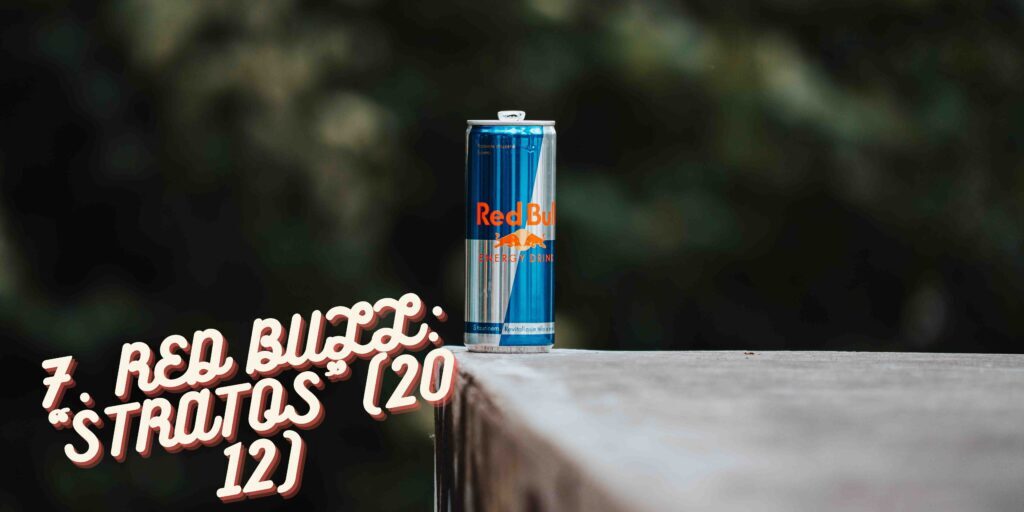
8. Absolut Vodka: “The Absolut Bottle” (1980)
Absolut Vodka’s print campaign featured its bottle in various creative, artistic settings, becoming one of the longest-running ad campaigns ever. It showcased the brand’s creativity and sophistication, helping Absolut gain a significant share of the vodka market.
An Iconic Silhouette Takes Center Stage
Launched in 1980, Absolut Vodka’s “The Absolut Bottle” campaign turned a simple bottle into one of the most recognizable figures in advertising history. Rather than focusing on the vodka itself, the campaign highlighted the distinctive shape of the Absolut bottle. Through a series of creative print ads that cleverly incorporated the bottle into various themes and settings, Absolut not only showcased its product but also established a brand identity synonymous with artistry, creativity, and sophistication.
Crafting a Visual Legacy
The strategy behind “The Absolut Bottle” campaign was groundbreaking for its time, relying on visual storytelling and minimal text. Each ad was a variation on the theme “Absolut [Something],” where the bottle was integrated into endless imaginative scenarios. This approach allowed Absolut to stand out in a crowded market, turning the bottle into a canvas for artistic expression. The campaign’s success was amplified by its appeal to a wide audience, including those interested in art, design, and culture, further elevating the brand’s status.
Transforming Brand Perception
“The Absolut Bottle” campaign had a transformative effect on Absolut Vodka’s brand perception. It propelled the brand from a little-known Swedish vodka to a global icon, significantly boosting sales and market share. The campaign’s longevity and the diversity of its creative executions kept the brand fresh and relevant for decades. Absolut became more than just a vodka; it became a symbol of creativity and a collector’s item for fans of the campaign’s artistry.
Lessons in Brand Differentiation
Absolut Vodka’s “The Absolut Bottle” campaign offers timeless lessons in the power of brand differentiation through consistent and creative visual marketing. It demonstrates how a single, simple product feature can be leveraged to create a strong, enduring brand identity. For marketers, Absolut’s approach underscores the importance of creativity and visual storytelling in building a brand that not only stands out but also resonates deeply with consumers across different interests and lifestyles.

9. McDonald’s: “I’m Lovin’ It” (2003)
Launched globally in 2003, “I’m Lovin’ It” is perhaps McDonald’s most successful campaign, creating a catchy jingle that became synonymous with the brand. It marked a shift towards a more positive, inclusive brand image, appealing to a broader audience.
An Iconic Silhouette Takes Center Stage
Launched in 1980, Absolut Vodka’s “The Absolut Bottle” campaign turned a simple bottle into one of the most recognizable figures in advertising history. Rather than focusing on the vodka itself, the campaign highlighted the distinctive shape of the Absolut bottle. Through a series of creative print ads that cleverly incorporated the bottle into various themes and settings, Absolut not only showcased its product but also established a brand identity synonymous with artistry, creativity, and sophistication.
Crafting a Visual Legacy
The strategy behind “The Absolut Bottle” campaign was groundbreaking for its time, relying on visual storytelling and minimal text. Each ad was a variation on the theme “Absolut [Something],” where the bottle was integrated into endless imaginative scenarios. This approach allowed Absolut to stand out in a crowded market, turning the bottle into a canvas for artistic expression. The campaign’s success was amplified by its appeal to a wide audience, including those interested in art, design, and culture, further elevating the brand’s status.
Transforming Brand Perception
“The Absolut Bottle” campaign had a transformative effect on Absolut Vodka’s brand perception. It propelled the brand from a little-known Swedish vodka to a global icon, significantly boosting sales and market share. The campaign’s longevity and the diversity of its creative executions kept the brand fresh and relevant for decades. Absolut became more than just a vodka; it became a symbol of creativity and a collector’s item for fans of the campaign’s artistry.
Lessons in Brand Differentiation
Absolut Vodka’s “The Absolut Bottle” campaign offers timeless lessons in the power of brand differentiation through consistent and creative visual marketing. It demonstrates how a single, simple product feature can be leveraged to create a strong, enduring brand identity. For marketers, Absolut’s approach underscores the importance of creativity and visual storytelling in building a brand that not only stands out but also resonates deeply with consumers across different interests and lifestyles.
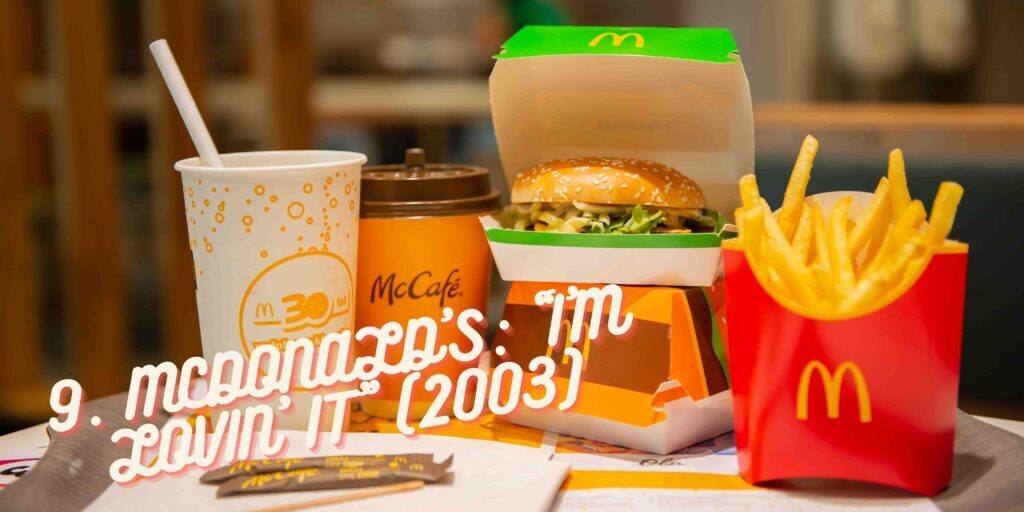
10. De Beers: “A Diamond is Forever” (1947)
This campaign established the diamond engagement ring as a societal norm and cemented De Beers’ monopoly on the diamond market for decades. The enduring slogan “A Diamond is Forever” not only promoted the product but also the idea of eternal love, showcasing the profound impact advertising can have on culture.
Sparkling a Tradition
In 1947, De Beers’ “A Diamond Is Forever” campaign revolutionized the diamond industry and established the diamond engagement ring as a universal symbol of love and commitment. This masterstroke of marketing not only positioned diamonds as the ultimate expression of love but also ingeniously suggested that their value, both emotional and monetary, is eternal. The campaign’s timeless slogan encapsulated the idea that diamonds, much like true love, are everlasting.
Carving Out Emotional Value
The brilliance of the “A Diamond Is Forever” campaign lay in its ability to infuse diamonds with deep emotional significance. By linking diamonds to the concept of forever, De Beers not only marketed a product but also sold an idea—the idea that giving a diamond as a symbol of love was an essential part of the marriage proposal ritual. This narrative transformed diamonds from a luxury item into a must-have for engagements and weddings, creating a new cultural norm.
Reinventing the Diamond Market
The impact of the campaign was profound and enduring. “A Diamond Is Forever” didn’t just boost diamond sales; it effectively created a tradition that propelled the diamond engagement ring to become a societal expectation in many cultures. It cemented De Beers’ position at the top of the diamond industry and made the diamond ring a staple of marriage proposals worldwide. The slogan has been honored as the best advertising slogan of the twentieth century, demonstrating the campaign’s unparalleled influence on both the market and popular culture.
Lessons in Crafting Legacy
De Beers’ “A Diamond Is Forever” campaign offers timeless lessons in marketing and brand storytelling. It shows how a powerful, simple message can transform a product and forge new traditions. For marketers, the campaign is a masterclass in creating and attaching emotional value to a product, demonstrating that with the right message, a brand can not only influence consumer behavior but also embed itself into the fabric of society.
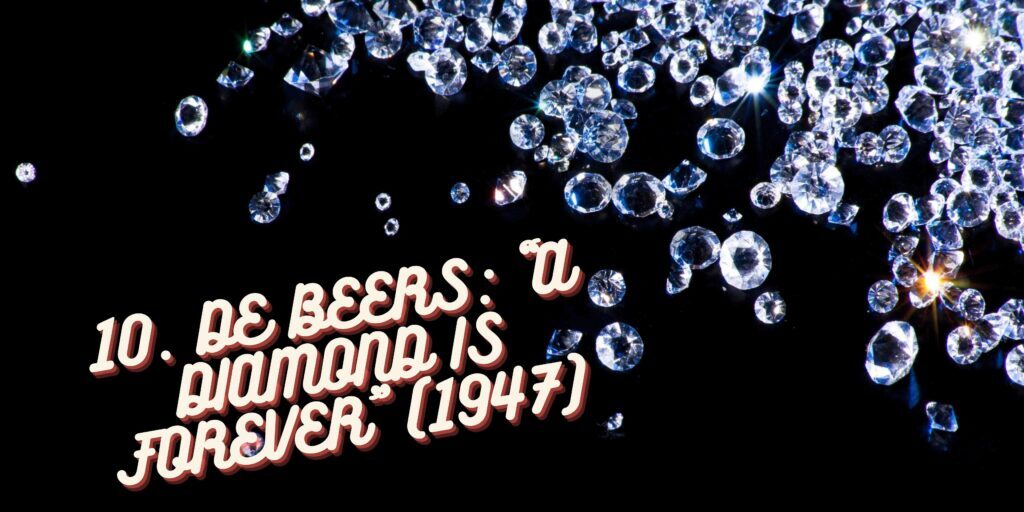
11. Always: “#LikeAGirl” (2014)
Always turned a phrase that had become an insult into an empowering message about the strength and capability of girls. The campaign challenged gender stereotypes, driving a conversation about confidence and resilience among young women.
Challenging Stereotypes with Empowerment
In 2014, Always launched the “#LikeAGirl” campaign, a pivotal moment in advertising that sought to redefine the phrase “like a girl” from an insult into a powerful statement of strength. By highlighting the impact of societal stereotypes on young girls’ self-confidence, Always not only promoted its brand but also sparked a global conversation about gender biases and empowerment. The campaign used a simple yet profound question to challenge and change the negative perceptions associated with doing anything “like a girl.”
A Viral Movement for Positive Change
The strategy behind “#LikeAGirl” was to leverage social media’s reach to engage a broad audience in a meaningful discussion about gender stereotypes. The campaign video, showing people of different ages interpreting the phrase “like a girl,” brilliantly contrasted the unapologetic confidence of young girls with the conditioned responses of older participants. This striking depiction underscored the campaign’s message: that doing something “like a girl” should mean doing it with strength, skill, and pride. The viral success of the campaign video, coupled with the encouragement for viewers to share their own #LikeAGirl stories, turned a marketing initiative into a social movement.
Impact Beyond the Brand
The “#LikeAGirl” campaign transcended its role as an advertisement, becoming a catalyst for societal change. It not only raised awareness about the importance of empowering young girls during puberty—a critical time for developing self-esteem—but also helped Always strengthen its brand identity as an advocate for girls’ and women’s empowerment. The campaign received widespread acclaim, winning numerous awards and setting a new standard for purpose-driven marketing.
Lessons in Purpose-Driven Marketing
Always’ “#LikeAGirl” campaign illustrates the profound impact that purpose-driven marketing can have on societal perceptions and brand engagement. It shows that when brands align their marketing efforts with a meaningful cause, they can contribute to positive social change while fostering deep connections with their audience. For marketers, the success of “#LikeAGirl” underscores the value of authenticity and the power of campaigns that challenge societal norms and inspire action.

12. IKEA: “Bookbook” (2014)
In a clever parody of Apple’s product ads, IKEA’s “Bookbook” campaign introduced its annual catalog in a tongue-in-cheek manner, highlighting the tactile and user-friendly features of a printed catalog. This approach cleverly leveraged digital video to promote a traditional medium, showcasing IKEA’s innovative and humorous brand personality.
A Witty Ode to Simplicity
In 2014, IKEA introduced the “BookBook” campaign, a clever and satirical advertisement that parodied high-tech product launches, specifically targeting Apple’s marketing style. By presenting its annual catalog as a groundbreaking innovation, IKEA celebrated the tactile joy and simplicity of a printed catalog in an increasingly digital world. The “BookBook” campaign was not only a testament to IKEA’s commitment to clever design and functionality but also showcased the brand’s distinctive sense of humor and ability to engage with cultural conversations.
Reinventing the Catalog
The strategy behind the “BookBook” was to highlight the enduring value of IKEA’s printed catalog in a marketplace dominated by digital media. Through a series of mock tech-launch features—such as “eternal battery life” and “no lag”—the campaign playfully positioned the catalog as the ultimate user-friendly, “wireless” device. This approach not only garnered attention for its creativity but also underscored IKEA’s understanding of consumer behavior and its dedication to making life at home simpler and more enjoyable.
Viral Impact and Brand Affection
The “BookBook” campaign quickly went viral, with the launch video amassing millions of views and sparking widespread media coverage. By tapping into the zeitgeist with humor and a clever premise, IKEA reinforced its brand identity as innovative and consumer-centric. The campaign resonated with audiences globally, demonstrating the power of creative storytelling and the appeal of blending traditional marketing with contemporary cultural trends.
Lessons in Creative Storytelling
IKEA’s “BookBook” campaign offers valuable lessons in the effectiveness of using humor and cultural relevance to create a memorable marketing message. It shows that innovative storytelling and a playful approach to product features can elevate a brand’s appeal and engage consumers in a saturated market. For marketers, “BookBook” serves as a prime example of how to differentiate your brand by embracing creativity, simplicity, and a deep understanding of consumer preferences.

13. Budweiser: “Wassup” (1999)
Budweiser’s “Wassup” campaign became a cultural catchphrase, showcasing a group of friends greeting each other over the phone. Its success lay in its simplicity, humor, and relatability, significantly boosting Budweiser’s brand recognition and sales.
Catchphrase Culture Phenomenon
In 1999, Budweiser captured the zeitgeist with its “Wassup” campaign, a series of commercials that turned a simple greeting among friends into a global catchphrase. This iconic ad campaign featured a group of friends answering the phone with an exaggerated, elongated “Wassuuup,” humorously depicting how true friends connect. The simplicity and relatability of the concept, paired with its humorous execution, resonated deeply with audiences, making “Wassup” an instant cultural staple.
The Power of Relatability
The strategy behind the “Wassup” campaign was to showcase Budweiser not just as a beer, but as a companion to good times among friends. The ads’ emphasis on friendship, relaxation, and enjoyment tapped into universal desires for connection and belonging, making the campaign appealing to a broad audience. By leveraging a casual, everyday scenario, Budweiser strengthened its image as a laid-back, approachable brand that’s present in life’s simple, enjoyable moments.
Beyond Beer: A Viral Sensation
The “Wassup” campaign went beyond traditional advertising boundaries, becoming a part of popular culture. It inspired parodies, references in movies and TV shows, and was adopted by people worldwide as a playful way to greet friends. The campaign’s viral success significantly boosted Budweiser’s brand recognition and affinity, demonstrating the power of memorable, culturally resonant advertising.
Lessons in Memorable Messaging
Budweiser’s “Wassup” campaign offers key lessons in creating advertising that sticks. It shows that memorable marketing often comes from highlighting relatable, authentic human experiences with a touch of humor. For marketers, the campaign underscores the importance of crafting messages that can easily be integrated into everyday conversation, ensuring the brand remains top of mind in a fun and natural way.
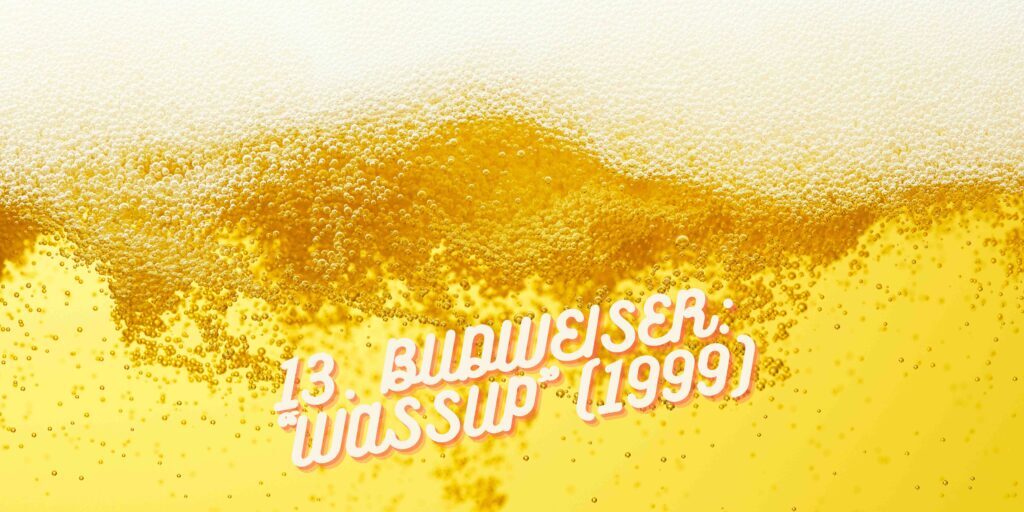
14. Google: “Parisian Love” (2009)
In this ad, Google tells a love story through a series of search queries, from study abroad programs in Paris to learning how to assemble a crib. “Parisian Love” showcased the personal and emotional journeys that Google Search could facilitate, highlighting the search engine’s role in our daily lives.
A Love Story Told Through Search
In 2009, Google’s “Parisian Love” ad campaign beautifully demonstrated the integral role of its search engine in people’s lives by telling a poignant love story entirely through Google search queries. From asking about study abroad programs in Paris to learning how to impress a French girl and eventually looking for engagement rings, the ad followed an American’s journey of love, illustrating how Google is there for every step of life’s key moments. This simple yet powerful narrative showcased the emotional connection users have with Google, far beyond its utility as a search engine.
Connecting Emotionally Through Technology
The genius of the “Parisian Love” campaign was its ability to humanize the technology, showing that behind every search query is a person with hopes, dreams, and desires. By focusing on the universal theme of love and the pursuit of happiness, Google effectively communicated the message that its technology is an enabler of human experiences. This approach not only highlighted the functional benefits of using Google but also fostered a deeper emotional engagement with the brand.
Impact and Reception
“Parisian Love” was a departure from Google’s typical advertising approach, marking one of its first forays into storytelling. The ad’s debut during the Super Bowl broadened its reach, resonating with millions of viewers and earning praise for its creativity and emotional depth. It underscored Google’s presence in the minutiae of daily life and its ability to facilitate personal connections, thereby strengthening the brand’s image as an indispensable part of the modern digital experience.
Lessons in Subtle Storytelling
Google’s “Parisian Love” campaign illustrates the power of storytelling in marketing, even for brands that are fundamentally technology-oriented. It shows that effective storytelling can transform a brand from a provider of services or products into a vital companion in life’s journey. For marketers, this campaign serves as a masterclass in crafting engaging narratives that connect emotionally with audiences, using subtlety and relatability rather than overt persuasion.
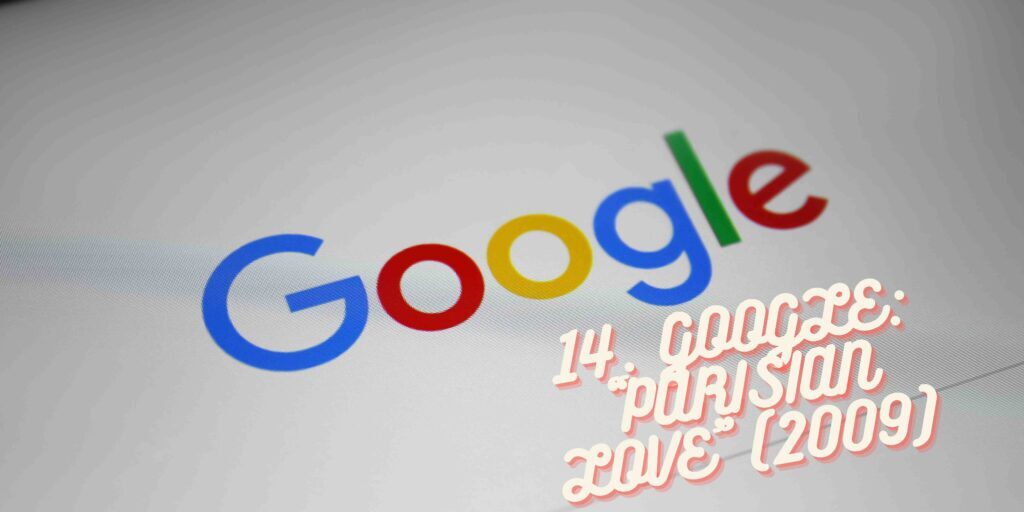
15. Chipotle: “Back to the Start” (2011)
Chipotle’s “Back to the Start” animation, featuring Willie Nelson covering Coldplay, highlighted the brand’s commitment to sustainable farming. The emotional storytelling and focus on corporate responsibility resonated with consumers, setting a precedent for mission-driven advertising.
Advocating Sustainable Farming through Animation
Chipotle’s “Back to the Start” campaign, launched in 2011, utilized a touching animated short film to advocate for sustainable farming practices. The film follows the journey of a farmer as he transforms his family farm into an industrial animal factory before seeing the error of his ways and opting for a more sustainable future. Set to Willie Nelson’s rendition of Coldplay’s “The Scientist,” the campaign not only highlighted Chipotle’s commitment to responsible sourcing but also sparked a conversation about the food industry’s impact on the environment.
A Story of Conscious Consumption
The strategy behind “Back to the Start” was to illustrate the consequences of industrial farming while also presenting a hopeful message about the possibility of change. By choosing animation, Chipotle was able to convey a complex message in a simple, emotionally compelling way. This approach not only engaged viewers but also aligned with the brand’s ethos of transparency and responsibility in sourcing ingredients. The campaign’s narrative encouraged consumers to think more critically about where their food comes from, positioning Chipotle as a leader in the movement toward sustainability in the food industry.
Impact Beyond the Ad
“Back to the Start” garnered widespread acclaim for its innovative storytelling and impactful message, earning numerous awards and setting a new standard for corporate social responsibility campaigns. The ad played a significant role in elevating Chipotle’s brand reputation, reinforcing its commitment to integrity and ethical practices. By leveraging its platform to advocate for positive change, Chipotle not only differentiated itself in the fast-casual dining space but also contributed to a broader dialogue about sustainability and ethical consumption.
Lessons in Brand Values and Storytelling
The “Back to the Start” campaign offers key insights into how brands can use storytelling to communicate their values and engage with consumers on a deeper level. It demonstrates the effectiveness of addressing larger societal issues through marketing, provided those issues align with the brand’s core values. For marketers, Chipotle’s approach underscores the importance of authenticity and the potential for brands to lead by example in promoting change, showing that powerful storytelling can resonate with audiences and drive meaningful conversations.
Each of these campaigns demonstrates the power of advertising to not only drive commercial success but also to touch hearts, change minds, and sometimes even alter societal norms. From leveraging humor and emotional storytelling to pioneering viral marketing and championing social causes, these iconic campaigns have left an indelible mark on the advertising landscape. They illustrate the creativity, strategic thinking, and bold execution that define the industry’s best work, providing inspiration and insight for future generations of advertisers.
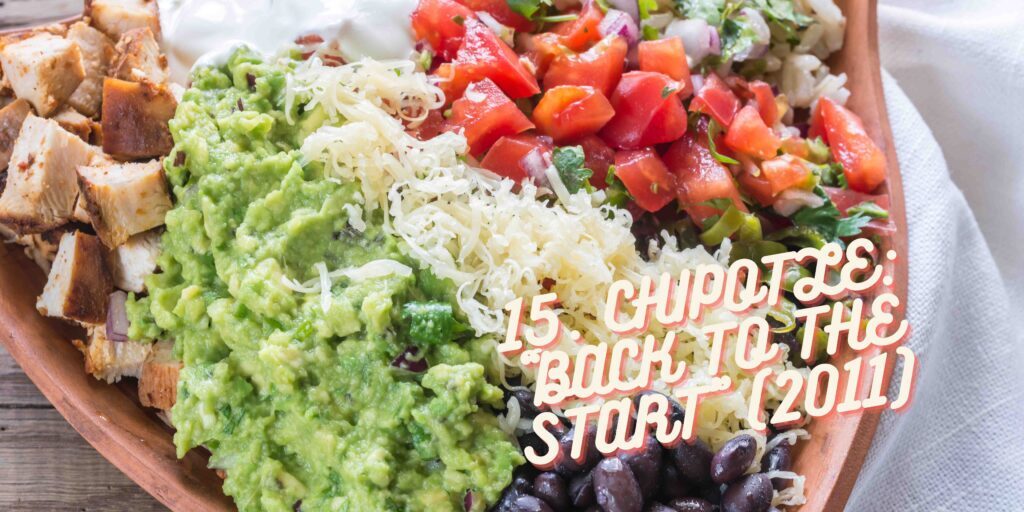
Case Studies on Advertising Challenges and Solutions
- Overcoming Ad Fatigue: Coca-Cola’s “Share a Coke” campaign is a stellar example of combating ad fatigue. By personalizing bottles with common names and encouraging sharing, Coca-Cola turned a simple idea into a worldwide sensation. This campaign revitalized the brand’s image, demonstrating the power of personalization in cutting through the noise.
- Navigating Platform Saturation: Nike’s approach to platform saturation exemplifies strategic platform selection and content adaptation. By leveraging its strong brand presence on social media, Nike creates platform-specific content that resonates with its diverse audience segments. From inspirational Instagram posts to engaging Twitter challenges, Nike maintains relevance by tailoring its message to each platform’s unique environment.
- Addressing Privacy and Data Concerns: The GDPR introduction in Europe prompted many advertisers to rethink their data collection and usage practices. One notable response came from Apple, which emphasized its commitment to privacy with the “Privacy. That’s iPhone” campaign. This move not only aligned with regulatory demands but also strengthened consumer trust in the brand.
The evolution of advertising from traditional to digital mediums has been driven by both technological advancements and changing consumer behaviors. The journey reflects a shift from a focus on product features to creating meaningful connections with consumers. Advertisers have adapted to these changes by embracing new platforms, refining their messaging, and leveraging data analytics to tailor their campaigns to specific audience needs.
However, the transition to digital has not been without challenges. Advertisers must constantly innovate to overcome obstacles such as ad fatigue, platform saturation, and privacy concerns. Despite these hurdles, successful case studies demonstrate that creativity, strategic platform use, and a commitment to ethical advertising can lead to impactful campaigns that resonate with consumers.
As we delve into the complexities of advertising in the digital age, it becomes evident that the key to effective advertising lies in understanding and adapting to the evolving landscape. By exploring the foundations of advertising, we gain insights into the strategies that have shaped successful campaigns and the challenges that continue to drive innovation in the field.
Emerging Advertising Platforms
- The advent of AR/VR and interactive advertising represents the cutting edge of advertisement delivery, pushing the boundaries of engagement and personalization.
- Augmented Reality (AR): AR ads overlay digital information on the real world, offering interactive experiences that can transform a mundane environment into a dynamic advertising space. For example, IKEA’s AR app allows users to visualize furniture in their homes before making a purchase.
- Virtual Reality (VR): VR ads immerse users in a completely digital environment, providing an unparalleled depth of engagement. Automotive brands like Audi have leveraged VR to offer virtual test drives, enhancing the consumer experience.
- Interactive Ads: These ads require user interaction, which increases engagement rates significantly. From simple web banner games to elaborate social media filters, interactive ads create memorable experiences that foster deeper brand connections.
Comparative Analysis of Advertisement Types by Industry
The effectiveness of each advertising type can vary significantly across different industries, influenced by factors such as target audience behavior, product type, and marketing goals.
- Retail: Social media and digital display ads are highly effective for the retail industry, allowing for targeted campaigns that drive online and in-store sales. Print catalogs and email marketing also play crucial roles in customer retention and engagement.
- Automotive: Television and VR advertising stand out for automotive brands, offering the visual impact needed to showcase vehicle features and the immersive experience potential buyers crave.
- Technology: Digital advertising, particularly SEM and social media, are pivotal for the tech industry, catering to an audience that spends considerable time online. Influencer marketing has also become a significant avenue for tech products, leveraging credibility and niche audiences.
- Healthcare: Print and radio ads remain vital for local healthcare services, offering accessibility to a broad demographic. Digital platforms are increasingly used for specialized services, utilizing targeted ads to reach specific patient groups.
- Entertainment: Social media and interactive ads are indispensable for the entertainment industry, creating buzz and engagement around new releases or events. Television advertising also plays a significant role in reaching a wide audience quickly.
The diversity of advertisement types and techniques reflects the dynamic nature of the advertising industry, constantly evolving to meet changing consumer behaviors and technological advancements. From traditional print and broadcast media to innovative AR/VR experiences, advertisers have a wide array of tools at their disposal to craft compelling campaigns that resonate with their target audience.
Emerging platforms like AR and VR are redefining engagement, offering immersive experiences that not only capture attention but also create lasting brand impressions. Meanwhile, the use of interactive ads across digital and social media platforms fosters a two-way dialogue between brands and consumers, enhancing the effectiveness of advertising efforts.
The comparative analysis of ad types by industry underscores the importance of selecting the right advertising mix to achieve marketing objectives. By understanding the unique characteristics and benefits of each ad type, advertisers can craft strategies that leverage the strengths of various mediums, ensuring their message reaches and impacts their intended audience.
As we move forward, the advertising landscape will continue to evolve, driven by technological innovation and shifting consumer expectations. Advertisers who stay ahead of these trends, embracing new platforms and techniques, will be best positioned to create effective, memorable campaigns that drive business success.
Crafting Effective Advertisements
The art of crafting effective advertisements lies in an advertiser’s ability to blend creativity with strategic execution. At the heart of memorable ads are core elements that resonate with audiences, compel action, and foster a connection with the brand. Understanding and implementing these elements can significantly enhance the impact of advertising efforts.
Elements of a Good Advertisement
-
- Messaging: The foundation of any effective advertisement is its message. A clear, concise, and compelling message that communicates the value proposition and differentiates the brand from competitors is essential. The best messages are those that speak directly to the audience’s needs, desires, or pain points, making the product or service presented as the solution.
- Storytelling: Humans are naturally drawn to stories. Advertisements that tell a story, whether it’s the brand’s journey, customer testimonials, or a fictional narrative, tend to engage audiences more deeply. Storytelling not only entertains but also helps to humanize the brand, making it more relatable and memorable.
- Emotional Appeal: Ads that evoke emotions—be it happiness, nostalgia, empathy, or even fear—are more likely to be remembered and acted upon. Emotional connections can significantly influence consumer behavior, making this element a powerful tool in the advertiser’s arsenal.
- Visuals and Design: In a world where consumers are constantly bombarded with information, visually appealing ads can capture attention and make a lasting impression. The use of color, imagery, and typography should align with the brand identity and message, creating a cohesive and attractive presentation.
- Call-to-Action (CTA): An effective advertisement always includes a clear call-to-action, guiding the audience on what to do next. Whether it’s visiting a website, making a purchase, or joining a social media conversation, a well-crafted CTA can significantly increase conversion rates.
Looking Forward – The Future Advertising
As we stand on the threshold of the future, the world of advertising continues to evolve, driven by innovation, ethical challenges, and the unending quest for connection. Advertisers who navigate this complex landscape with creativity, integrity, and a commitment to understanding their audience will lead the way. The continuous evolution of advertising is not just about the changing tools and technologies but about the timeless pursuit of engaging human hearts and minds.
In conclusion, the exploration of advertising’s past, present, and future reveals an industry that mirrors the human experience—constantly evolving, reflecting societal values, and striving for connection. As we look to the future, the lessons gleaned from history, the insights from today’s strategies, and the anticipation of tomorrow’s possibilities converge to guide us. Advertising, in essence, remains a powerful force for business, culture, and communication, capable of not only shaping consumer behavior but also reflecting and influencing the zeitgeist of the times.
In the tapestry of modern commerce and society, advertising stands as a vibrant thread, weaving together innovation, creativity, and strategic insight. Its journey continues, marked by the challenges it overcomes and the milestones it achieves, driven by the visionaries who dare to imagine and the audiences who engage and respond. As we embark on the next chapter of this ever-evolving story, the essence of advertising—as a catalyst for connection, a driver of change, and a reflection of our collective aspirations—remains enduringly significant.



